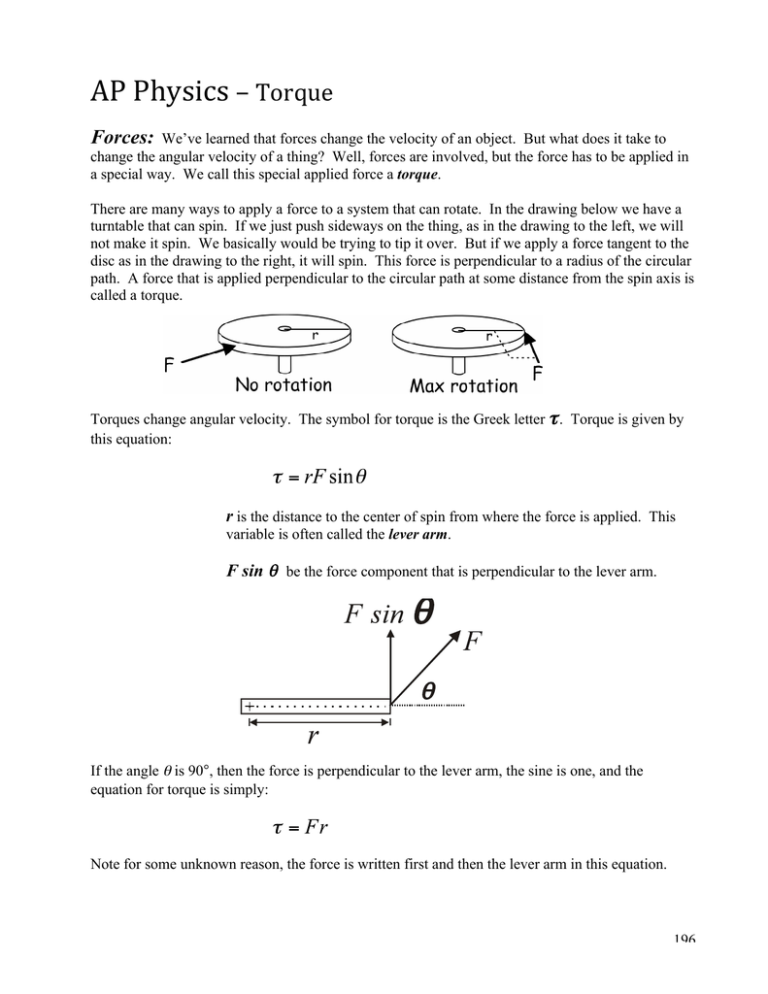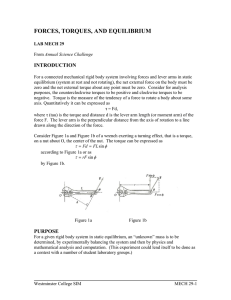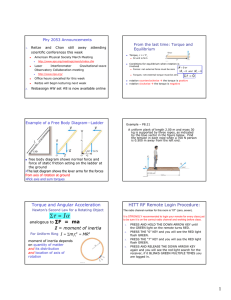AP Physics – Torque
advertisement

AP Physics – Torque Forces: We’ve learned that forces change the velocity of an object. But what does it take to change the angular velocity of a thing? Well, forces are involved, but the force has to be applied in a special way. We call this special applied force a torque. There are many ways to apply a force to a system that can rotate. In the drawing below we have a turntable that can spin. If we just push sideways on the thing, as in the drawing to the left, we will not make it spin. We basically would be trying to tip it over. But if we apply a force tangent to the disc as in the drawing to the right, it will spin. This force is perpendicular to a radius of the circular path. A force that is applied perpendicular to the circular path at some distance from the spin axis is called a torque. Torques change angular velocity. The symbol for torque is the Greek letter τ . Torque is given by this equation: r is the distance to the center of spin from where the force is applied. This variable is often called the lever arm. F sin θ be the force component that is perpendicular to the lever arm. If the angle θ is 90°, then the force is perpendicular to the lever arm, the sine is one, and the equation for torque is simply: Note for some unknown reason, the force is written first and then the lever arm in this equation. 196 You can see that the unit for torque is going to be a newton meter (nm). We leave it like that. This looks very similar to the unit for work, the joule, but it is quite different. So energy and work are in joules and torque is left in newton meters. Torque is a vector quantity. • 125 N is applied to a nut by a wrench. The length of the wrench is 0.300 m. What is the torque? • A torque of 857 Nm is applied to flywheel that has a radius of 45.5 cm. What is the applied force? • You push on the door as shown in the drawing. What is the torque? Multiple Torques: What happens if two or more torques act on an object at the same time? Two forces are applied to the object in the drawing to the right. The object is free to rotate about the spin axis. Both cause a torque. F1 causes a CCW (counter clockwise) rotation around the axis. F2 causes a CW (clockwise) rotation around the axis. If a torque causes a clockwise rotation, it is positive. If a torque causes a counter clockwise rotation, it is negative. 197 The sum of the two torques would be: Equilibrium and Torque:If an object is in angular equilibrium (sometimes called rotational equilibrium), then it is either at rest or else it is rotating with a constant angular: If object is in rotational equilibrium, the net torque about any axis is zero. This means that the sum of the torques acting on the object must be zero. ∑ τ =0 Static equilibrium exists when an object has no motion, either linear or angular. There are two conditions which must exist in order to have your good old static equilibrium: The net force must be zero and the net torque must be zero. ∑ F=0 ∑ τ =0 This gives us some very powerful tools to solve static problems. We can analyze a system and look at the forces acting on it, and we can also look at the torques that act on it. We’ll be able to do some really cool stuff. • Two metal orbs are attached to a very lightweight rigid wire. They are suspended from a rigid point on the overhead as shown. The system does not move. Calculate the distance from the suspension line to the center of gravity on the right sphere. Since the system is at rest, the sum of the torques and the sum of the forces must be zero. Let’s look at a FBD and a drawing showing the two torques: Without using the torque equilibrium, we could not solve the problem. The sum of forces would simply tell us that the upward force would be equal to weight of the two balls. 198 Using torque, however, allows us to solve the problem. All we have to do is add up d’ torques: Torque problems, as you have just seen, are fairly simple. Now we’ll do a classic teeter-totter beam problem. • A teeter-totter is in equilibrium as shown. The block on the left has a weight of 625 N. The beam itself has a weight of 32.5 N. What is the mass of the second block? This is a pretty simple problem, we can solve it using the torques. The sum of the torques must be zero: ∑τ=0 There are three torqes, τ 1 (from the 625 N rock) and τ 2 from the other rock. The weight of the beam (Fbeam), even though it has a significant amount of weight, does not cause a torque because the weight acts at the CG of the beam which is also the center of rotation. Thus the lever arm is zero. τ 2 is positive (CW) and τ 1 is negative (CCW) To find the mass we use the second law: 199 Another similar problem. • A 50.0 N seesaw supports two people who weigh 455 N and 525 N. The fulcrum is under the CG of the board. The 525 N person is 1.50 m from the center. (a) Find the upward force n exerted by fulcrum on the board. (b) Where does the smaller person sit so the seesaw is balanced? First, let’s draw a FBD We know that the system is in static equilibrium, so we can analyze the forces. In the y direction, the sum of the forces must be zero. (a) F1 and F2 are the weight of the two men, FT is the weight of the teeter-totter, and n is the normal force. We can write this out: Now we can solve for the normal force, this is the upward force exerted on the board by the support stand. (b) To find the distance the second man must be positioned from the center, we must analyze the torques. 200




